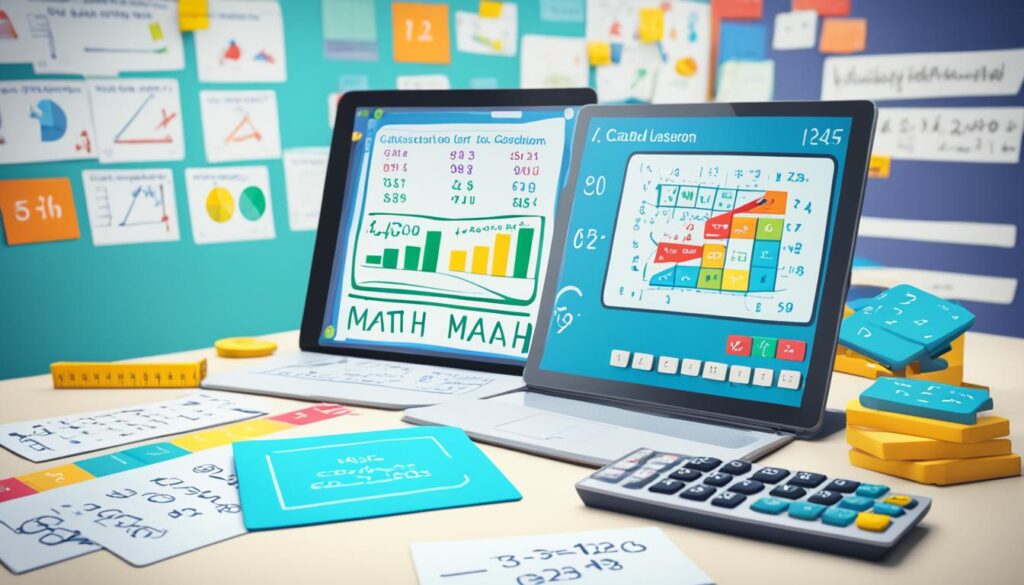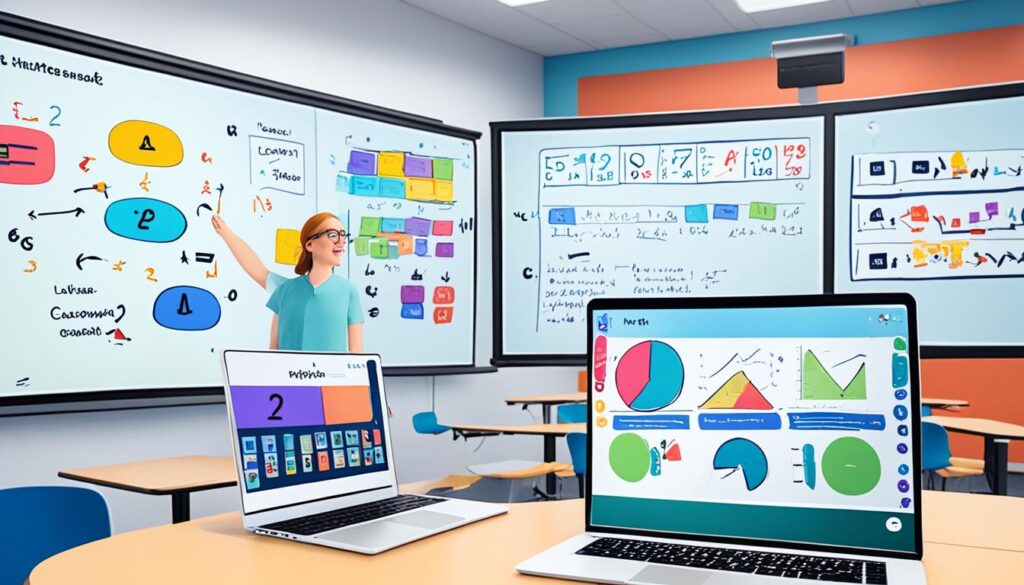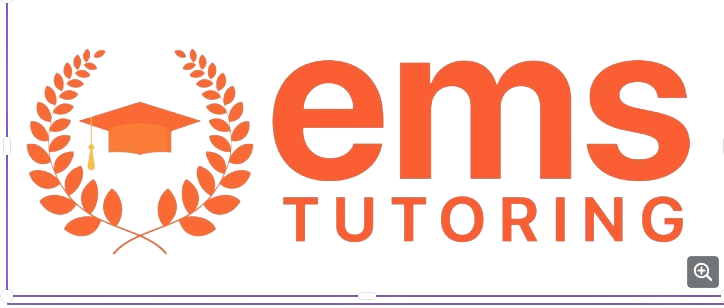Picture this: You’re in your favorite math class, waiting for the teacher. The whiteboard shows colorful diagrams and math equations. Everyone is excited, about to start a math adventure together.
You’re not in the classroom, though. You’re at home, looking at your laptop. Your class is happening online. The teacher is there on the screen, and everything feels real.
Online math lessons are changing how we learn math. They are fun and let you dive into math with your friends. You can work on algebra, geometry, or calculus. These lessons make learning easier and more fun.
Key Takeaways:
- Virtual math lessons provide engaging and interactive online learning experiences.
- They utilize a range of interactive math tools to enhance learning.
- Virtual math lessons can be tailored to fit any curriculum and grade level.
- Teachers have access to various resources and support for virtual math instruction.
- Virtual math lessons are a valuable asset in the world of online education.
Interactive Math Tools for Engaging Learning
Virtual math lessons have lots of interactive tools. These tools include fractals, flash cards, and timeline manipulatives. They help students think critically and solve problems better. Teachers everywhere use these tools to make math fun and interactive.
Imagine learning math through activities like Factris and origami. These tools make learning hands-on and fun. They help students understand complex ideas better, keeping them interested.
These math tools work in any learning setting, like virtual or at home. They offer an interactive way to teach math, no matter where the student is. This makes math learning more fun and engaging for students.
Engage students with interactive math tools and watch as they develop problem-solving and critical thinking skills in a virtual math classroom.
Engaging Math Tools for Interactive Learning
Here are some interactive math tools for virtual lessons:
- Fractals
- Flash cards
- Timeline manipulatives
- Graph theory
- Puzzles like Factris
- Origami
- Symmetry
These tools make learning math more than just writing on paper. Students really get into their learning through exploration. They understand math better and are excited to learn.
As teachers, we want to inspire our students with math. Virtual lessons are the way to go. They let us use fun, interactive tools. This way, students enjoy learning and really get into math.
Tailored Math Lessons for Different Curriculum
Virtual math lessons are flexible and can fit any curriculum. They help students from all grade levels and educational systems. Whether you use a set curriculum or learn in a personalized way, virtual math is there to help. It gives students the tools and resources they need to do well in math.
Online math tutoring and virtual math lessons provide special help for students. In these sessions, students work one-on-one with tutors who know a lot about math. They can get help with tough topics or try more challenging math. This makes learning math more personal and effective for each student.
Online math and tutoring blend to offer a great learning experience. They work for all learning styles and abilities. With online learning, students can fit extra math help into their busy lives. They won’t miss out on other activities or commitments.
Online math lessons and tutoring are great for any curriculum. They are perfect for remote learning, too. As more schools move online, these options ensure top-notch math education from anywhere.
Technology makes math learning more fun and engaging. Virtual math lessons use cool tools that traditional lessons don’t have. Things like virtual tools, visual aids, and hands-on exercises help students understand math better. It brings math to life!
Benefits of Tailored Math Lessons and Online Math Tutoring:
- Personalized instruction that caters to individual learning styles and abilities
- Flexible scheduling to accommodate busy student lives
- Access to experienced tutors specializing in math education
- Additional support and guidance for specific math topics
- Enhanced learning experience through interactive tools and resources
Virtual math education and tutoring offer a special math learning experience. They meet each student’s unique needs. The flexible online tools, personal instruction, and fun learning resources make learning math exciting. They help students do well in math and love the subject for life.
| Benefits of Tailored Math Lessons and Online Math Tutoring |
|---|
| Personalized instruction that caters to individual learning styles and abilities |
| Flexible scheduling to accommodate busy student lives |
| Access to experienced tutors specializing in math education |
| Additional support and guidance for specific math topics |
| Enhanced learning experience through interactive tools and resources |
Teacher Resources and Support for Virtual Math Instruction
Teaching math online requires special resources to make lessons engaging and effective. Teachers can find lots of free tools to help. These resources offer tips, ideas, and tools for a better online teaching experience.
Virtual math tutors are a big help for teachers. Places like EMS Tutoring offer these tutors. They provide one-on-one help and workshops. Teachers learn how to plan and teach great math lessons online.
Teachers can also find lesson plans and tutorials for free. These are great for making math lessons exciting and useful for students. It doesn’t matter if teachers need games, problem-solving help, or ways to teach different learners. These resources are there to help.
“Virtual math lessons offer a wealth of free teacher resources that can make this process easier and more effective.”
Online math lessons let teachers adjust how they teach. They can use resources to match each student’s learning style. This way, everyone gets a chance to do well in math.
| Benefits of Teacher Resources for Virtual Math Instruction | Examples of Teacher Resources |
|---|---|
| Support in planning and delivering virtual math lessons | Free lesson plans |
| Ideas for engaging math activities and strategies | Virtual math tutor |
| Guidance in using technology effectively | Events and webinars |
| Opportunities for professional development | Tutorials and workshops |
Using these resources, teachers can make online math classes fun and effective. With the right help, they can get students excited about math. This ensures every student can do their best in math.
The Power of Virtual Math Instruction in Online Learning
Virtual math instruction is key in remote learning. It lets students learn no matter where they are. Teachers use tech like Google Meet and Zoom for online classes. These tools bring students together and improve learning.
Through online platforms, students get interesting lessons. Teachers share different materials, like online books and tools. This makes math fun and easy to learn. Teachers can also see how students are doing in real time. This helps them give extra help when needed.
This type of learning isn’t limited by walls. It lets students everywhere join in, making math exciting. It also helps students think critically. Virtual math instruction makes everyone feel included and connected.
“Virtual math instruction empowers students to actively participate in their own education, regardless of where they are located. It brings learning to life, encouraging students to explore mathematical concepts and develop problem-solving skills in a dynamic and interactive environment.”
In online math, working with others is also easy. Students can talk with friends and solve problems together. This helps in understanding math better.
Online math classes are flexible. Students can learn at their own speed. This helps each student learn in a way best for them. It leads to a better grasp of math.
The Benefits of Virtual Math Instruction:
- Engaging and interactive math lessons
- Access to a wide range of resources and materials
- Real-time monitoring of student progress
- Inclusive and connected learning experiences
- Promotes peer collaboration and interaction
- Flexible and personalized learning opportunities
Virtual math learning keeps getting better. It’s a great tool for high-quality math education. It prepares students well for the digital world.
Using Online Math Tools for Effective Teaching
Online math tools are key for virtual teaching. They boost learning for students. Educators can use these tools to make math lessons fun and interactive. This helps students engage and grasp math concepts in a dynamic way.
Visual Presentations with Google Slides or PowerPoint
Visuals are an awesome way to teach math online. Google Slides and PowerPoint help teachers make organized and clear presentations. They can even add charts and interactive parts. This makes learning more visual and fun for students.
Interactive Practice with Online Math Games Sites
Math games online spice up learning. They’re fun and cover various math topics. Students can play these games to better understand math. This turns learning into a game, pushing them to practice more.
Hands-on Learning with Virtual Manipulatives
Virtual manipulatives let students handle math tools on their devices. It’s like playing with real math tools but on a screen. They can explore topics such as fractions and geometry this way. This makes abstract math concepts easier to understand.
Adding online math tools to teaching changes how students learn math. These tools help personalize learning, making it more effective. Teachers can use visuals, online games, and virtual tools to make math engaging. This creates a better learning space for students.
Enhancing Virtual Math Instruction with Instructional Videos
Instructional videos are great for teaching math online. Teachers can make their own or find good ones online. These videos show step-by-step math solutions. They help students understand better by providing extra chances to study.
| Benefits of Online Math Tools for Effective Teaching |
|---|
| Engagement: Online math tools make learning fun and interactive, boosting student interest |
| Personalization: Each student gets a customized learning path that fits their style |
| Flexibility: Math tools are online and can be used anywhere, anytime |
| Progress Monitoring: Teachers can track student progress closely and give extra help where needed |
Online math tools are crucial for top-notch virtual math lessons. They make learning fun and effective. These digital resources support interactive activities and deeper math understanding. They promote student participation and collaboration online.
Enhancing Math Instruction with Virtual Graphs and Algebra
Virtual math tools are great for teaching graphs and algebra. They let students interact with math in new ways. By using virtual graphs, online games, and manipulatives, educators make learning fun and dynamic.
Virtual graphing has one key benefit: it makes math visual and exciting. Students can make and look at different graphs. They learn how to show data using charts and graphs.
Online math games are fun and help with learning. These games mix math with play, letting students practice graphing and algebra. This learning method is hands-on and practical.
“Online math games provide students with the opportunity to apply their graphing and algebraic skills in a fun and engaging way. By incorporating game elements, these virtual games not only reinforce students’ understanding but also motivate them to continue learning and exploring mathematical concepts.” – Emma Smith, Math Educator
Virtual manipulatives help explain hard math concepts. They let students touch and see math ideas in a simple way. For algebra and graphing, they show variables and functions clearly.
Implementing Virtual Math Instruction in Practice
Teachers must show math step by step using virtual tools. They can use screen sharing to teach graphing and algebra. Seeing math in action helps students a lot.
Math instruction should also have things for students to do. Teachers can make assignments that use virtual tools. These activities help students learn and think deeply about math.
Benefits of Virtual Math Instruction in Graphs and Algebra
Virtual math tools make learning graphs and algebra fun. They help students build a strong math foundation. This prepares them for harder math in the future.
Virtual math is also great for keeping students excited about learning. By mixing online games and interactive graphs, teachers make math interesting. This way, students want to participate more in class.
| Benefits of Virtual Math Instruction in Graphs and Algebra |
|---|
| Enhances visualization skills |
| Encourages active learning and critical thinking |
| Promotes student engagement and motivation |
| Supports the development of problem-solving abilities |
| Prepares students for higher-level math concepts |
Using virtual graphs, math games, and manipulatives makes teaching math better. Students learn more and enjoy math. Virtual math brings a new experience to the classroom. It helps students explore and do well in math.
Fostering Engagement and Collaboration in Online Math Learning
Teaching math online is more than just sending out assignments. It’s about making lessons interactive and collaborative. With the right strategies, you can turn your virtual classroom into an engaging space. This helps students actively participate and learn better.
Assigning Group Work
Create group tasks that need teamwork. This approach encourages students to work together. It also lets them see math problems from different angles. Teamwork enhances their problem-solving skills.
Utilizing Breakout Rooms
Breakout rooms are great for focused discussions. They are perfect for math lessons too. Students can talk through problems together. Make sure to guide them through any tough spots they find.
Encouraging Student Voice and Choice
Let students share their ideas. Allow them to lead discussions sometimes. Giving them choices, like picking their own math topics, can boost their interest and involvement in learning.
Facilitating Collaboration with Online Math Tools
Use tools like whiteboard.chat for real-time teamwork. They let students collaborate on math work. Virtual playing cards are also handy for math games that stimulate thinking and cooperation.
Engaging Discussion Boards, Assignments, and Small-Group Activities
Discussion boards and group tasks can make learning more interactive. They provide extra ways for students to connect with the material. These activities can help deepen their grasp of math concepts.
Assessing Math Learning in the Online Environment
Assessing math online needs careful thought. As a teacher, use online quiz makers and tools. These can check how well students grasp math ideas.
Online quiz makers show how well students know math fast. They let students see what they need to work on. Some good quiz maker sites are onlinequizcreator.com, QuizStar, and Google Forms. They help make fun quizzes to test students’ math knowledge.
Oral exams and projects also help see what students know. Oral exams let students speak about math to show what they understand. Projects, like making a math model or solving a problem, demonstrate how students apply what they’ve learned in life.
To make learning more real, let students choose how to show what they know. Giving choices lets students highlight their special skills. And, reflection helps students think about their learning and understand it better.
| Assessment Method | Description |
|---|---|
| Online Math Quiz Makers | Platforms like onlinequizcreator.com, QuizStar, and Google Forms offer automated assessments with quick feedback. |
| Oral Exams | Assess students’ problem-solving skills and their ability to communicate and apply math concepts verbally. |
| Culminating Projects | Encourage students to create a mathematical model or solve a complex problem to showcase their application of math concepts in real-life scenarios. |
| Student Choice and Self-Reflection | Integrate options for students to choose how they demonstrate their understanding and encourage self-reflection for a deeper understanding of their learning process. |
Using these methods helps you really understand your students’ math learning online. Give feedback quickly. Then, use what you find to teach better. Assessments are key to help students master math and become independent learners.
Embracing Online Teaching Strategies for Effective Math Instruction
Using online teaching strategies is key for good math teaching online. There are many ways to boost your online teaching. You can make a fun and engaging space for students to learn and talk about math.
Crafting On-Demand Instructional Videos
Make on-demand videos to help with math lessons online. Students can watch these videos whenever they want. Make sure to explain things clearly and use examples. Adding things like pictures and showing each step can help students understand better.
Setting Clear Objectives and Self-Checking Opportunities
Tell students what they will learn at the start of each math class online. Give them chances to check how well they understand things themselves. This can be through practice problems or quizzes. It helps students know what they need to work on.
Incentivizing and Assessing Student Revisions and Reflections
Encourage students to look back at their work and think about it. Offer rewards for hard work and improvement. This might be extra points or just praise. It’s important for students to want to learn more and get better.
Integrating Online Resources, Apps, and Tools
Make online math learning fun by using lots of tools and games. These can be from the internet or special math apps. They help students get better at math and have fun learning. Also, using websites for schoolwork makes it easier to turn in work and get feedback.
Analyzing and Enhancing Online Teaching Skills
Always work on making your online teaching better. Learn about new teaching tools and ways to teach. Talk to other teachers and keep learning yourself. This makes your online math class a fun place to learn.
By using these tips, you can make a great online math class. Use videos, clear goals, and tools to make learning fun. Keep learning and trying new things. This way, your students will do well in math and enjoy learning.
Conclusion
Virtual math lessons are not boring; they make learning math fun online. They use different interactive tools to teach math well on the web. This way, students get good at problem-solving and thinking critically about math.
Teachers can turn their online math classes into lively places with the right methods. These lessons make learning math better and help in the online education scene. They also let students work together better.
Students find math interesting through online lessons. They use cool tools and resources online to learn. This makes learning math easier and more fun. Students get really good at math this way.
Educators can improve their virtual math classes by using many online tools. These make teaching math more effective. It helps students like math more and be better at it. This builds a strong base for their future math learning.







